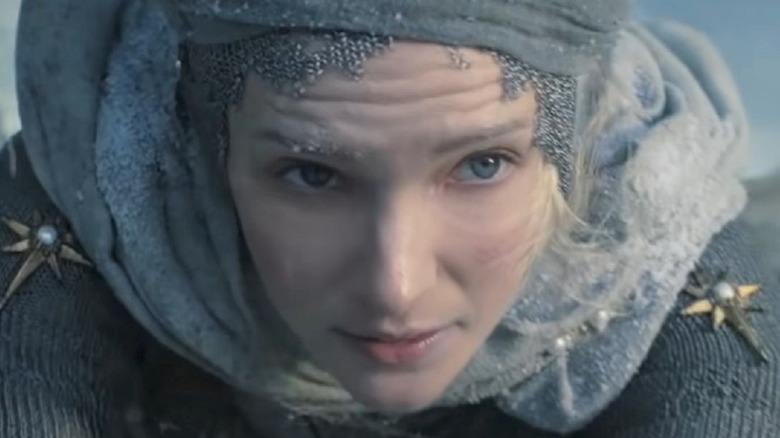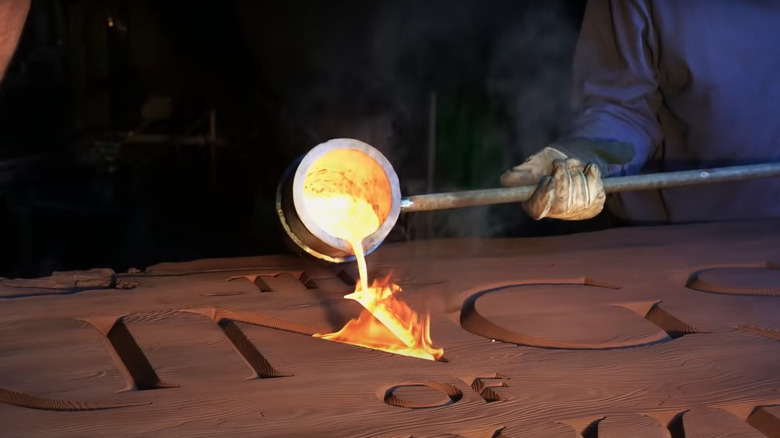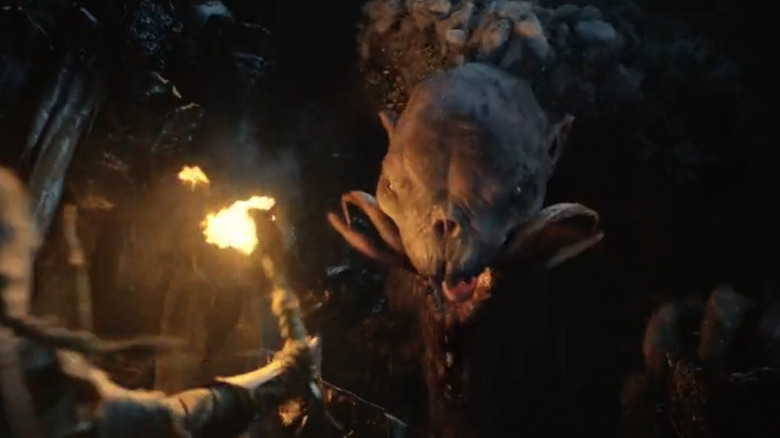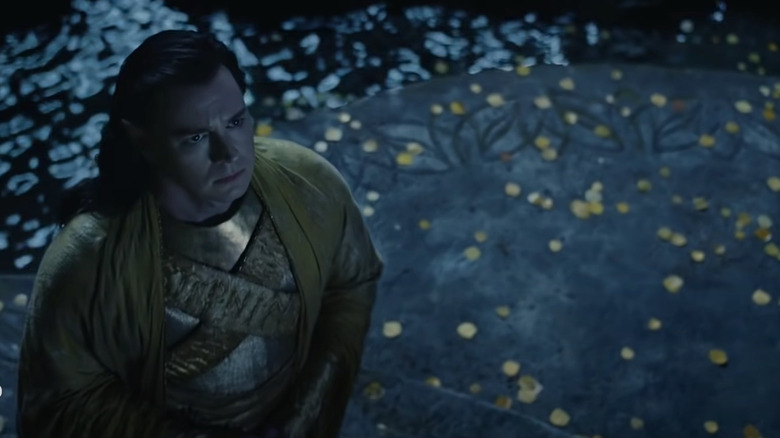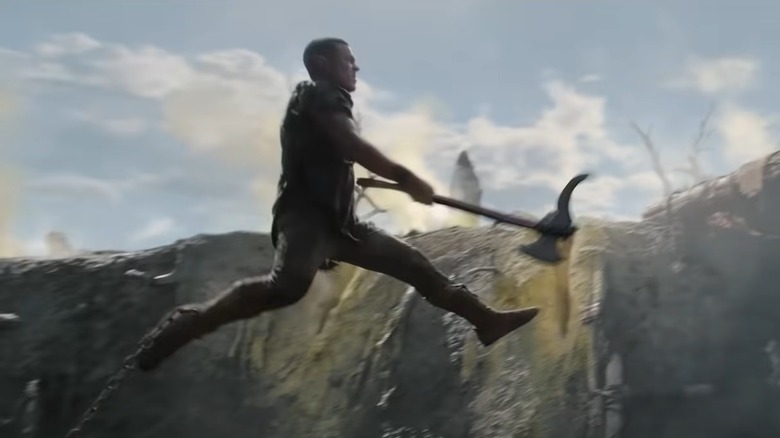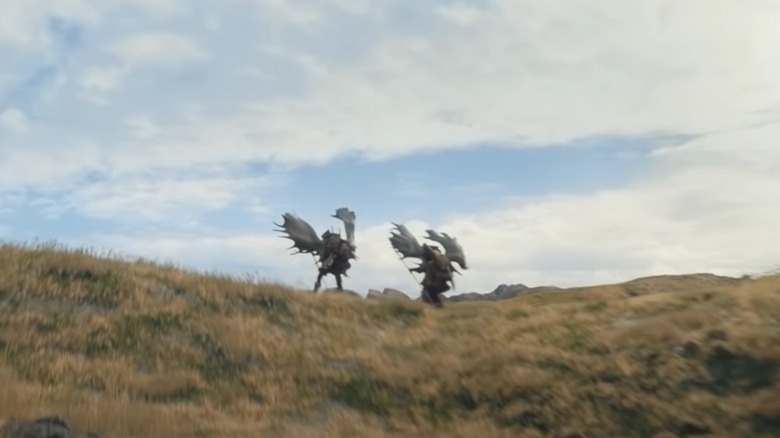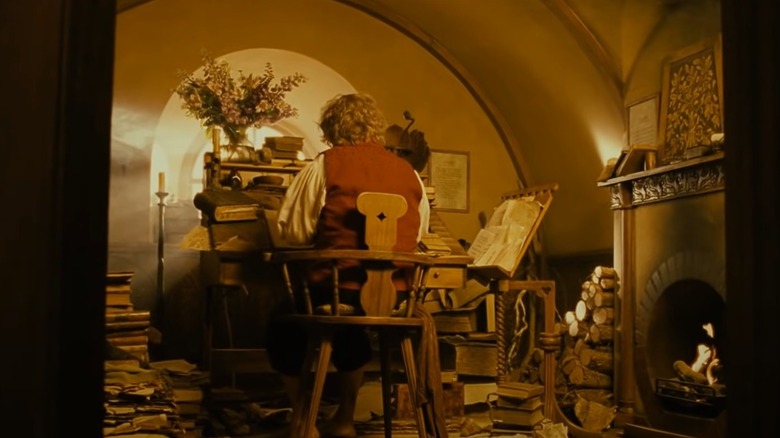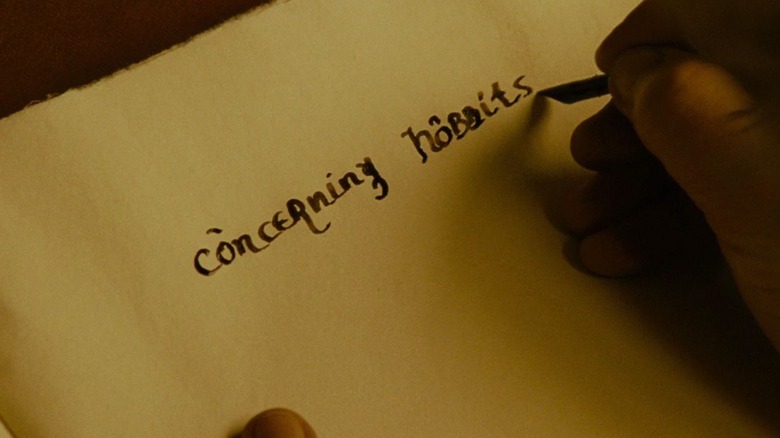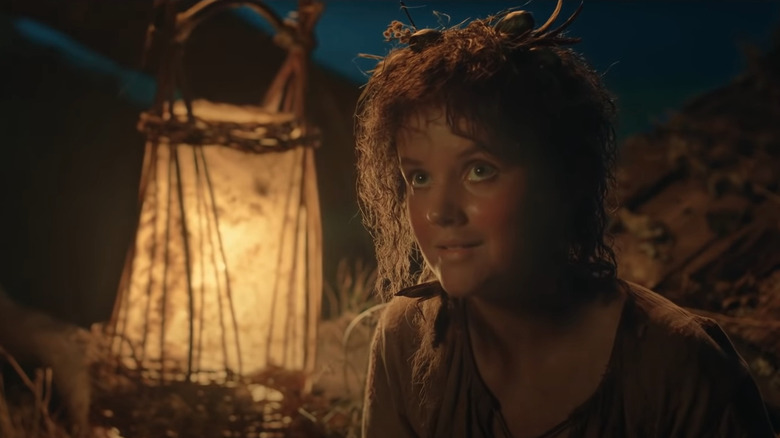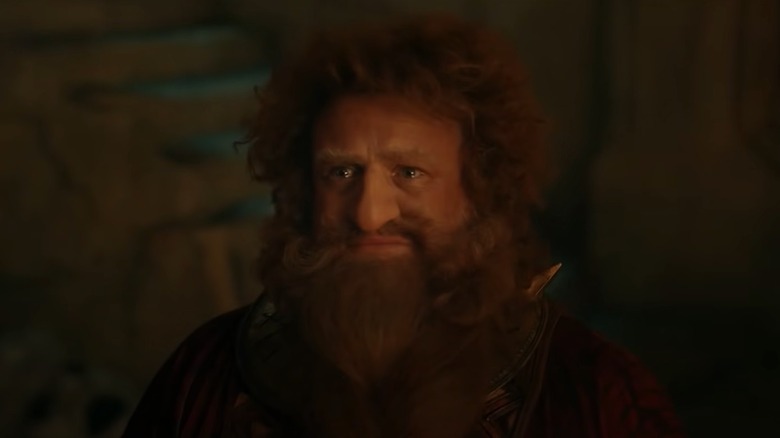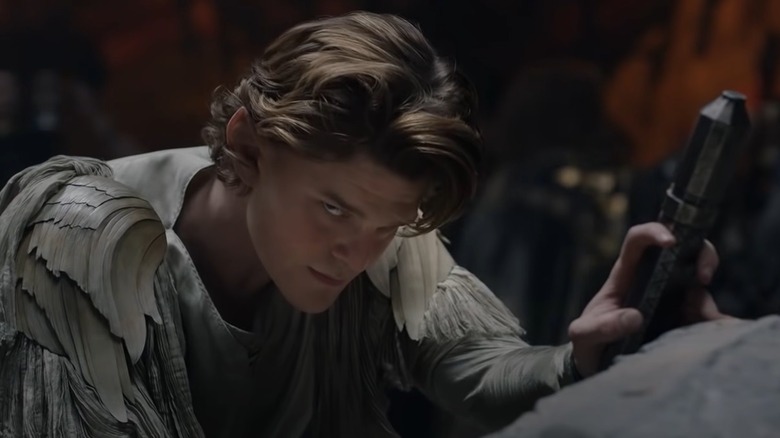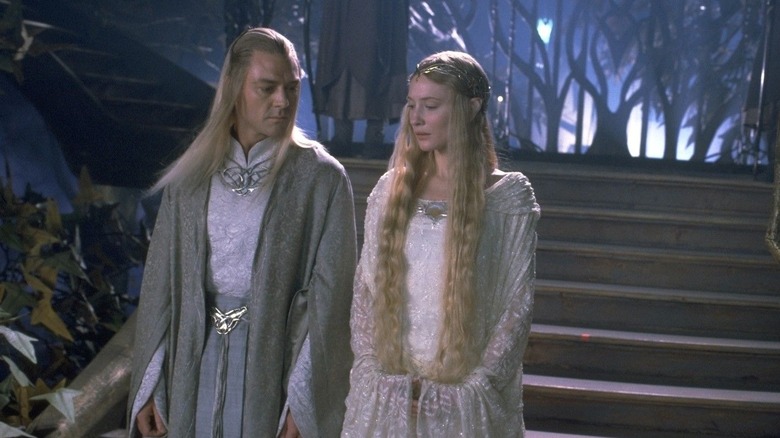Things That Have Us Worried About Amazon's Lord Of The Rings Series
In February, Amazon Studios ramped up the initial marketing campaign for its "The Lord of the Rings: The Rings of Power" series. Coming out in September 2022, the show promises to take viewers through a very different version of Middle-earth than what fans of Peter Jackson's cinematic adaptations are used to.
Set in the Second Age, the "Rings of Power" will delve into an era of Tolkien's world that the author himself never fully fleshed out — not by a long shot. In fact, strictly speaking, there isn't much more than a skeletal framework to use in telling the story, which is a blessing and a curse for an adaptation (more on that in a bit.)
Needless to say, when the promotional campaigns really kicked off in earnest, it had a divided response from Tolkien's avid fanbase. The initial backlash focused on elements like whether the elves should be exclusively depicted with long, Jacksonian locks and the endless debate over whether dwarven women should have beards. (Hint: They do and don't in different versions of Tolkien's writings.)
Now that the initial flurry of emotional responses has died down and we've all had time to mull on the substantial yet limited amount of information that Amazon has released, a few more significant concerns have cropped up that go much further than female facial hair. Here are some of the deeper points that have us worried when it comes to Amazon's upcoming "Rings of Power" show.
Are we going to get good effects?
Let's start with a pretty basic concern: the CGI and special effects. The pieces of generated imagery that we've seen so far have been a bit of a mixed bag. On the one hand, there's the title trailer. This was deliberately and masterfully shot with practical effects, doubtless in an attempt to send a message that the production was taking effects seriously.
On the other hand, we have the teaser trailer, which has drawn the ire of many fans due to its perceived poor CGI. From Galadriel climbing a cliff to an encounter with weird troll-thing, there's more than one point in that footage where the CGI isn't doing Amazon any favors. Of course, this is just promotional footage. It's entirely possible that they still have work to do to clean up those scenes before they're officially released. Still, what we've seen so far is anything but reassuring.
The thing is, this isn't the first time fans have worried about the use of special effects — and especially computer-generated graphics — in Middle-earth. "The Lord of the Rings" trilogy used the then-infantile CGI that it had available in very tasteful ways. But "The Hobbit" trilogy, which was made a decade later, completely ignored the Academy Award-laden success of the past and utilized CGI lavishly throughout its movies ... to the great dismay of viewers. The resulting computer-tastrophy was akin to watching a really, really long video game intro, and the dissatisfaction is still alive and well in the Tolkien community.
How will the show use its special effects?
The quality and use of CGI are both important factors that could make or break how people view the "Rings of Power" show. But there's another aspect of the special effects that's worth bringing up. In fact, it's so important that it deserves its own separate section: What about "splashy" effects? What do we mean by that? Let's break it down.
See, special effects can have a really great impact on a story. You can gussy up a line of actors to look like warriors in a battle line and then CGI a giant army behind them, and the final shot looks really cool. You can splice a quick CGI clip into the middle of an action sequence, and it can have a positive effect on the flow of the scene.
But you can also use this power for evil. We're talking about things like making a complete CGI character out of Jar Jar Binks way before the tech was ready to carry that kind of responsibility. These "splashy" uses of technology aren't just unnecessary. They often distract viewers and can even hurt the story.
In the case of "The Rings of Power," the question that already needs to be asked is how much CGI will play a part in actually telling the story. In the 60-second trailer, we already see things like big scary monsters and men crawling through fire. Will big, grandiose effects be the M.O. here, or will they just complement the bigger narrative being told?
Can they handle so many characters?
It's no secret that Middle-earth is brimming with characters. Tolkien invested countless hours into developing an endless number of incredible heroes and villains. These are sprinkled throughout Middle-earth's long history from the moment of creation all the way through to the War of the Ring.
Even when you narrow things down to a specific era in time, there are still a heckuva lot of names and faces to keep track of. For instance, unless you're a serious fan, chances are you can't spout off all nine members of the Fellowship of the Ring without thinking pretty hard.
When it comes to the Second Age, the problem persists. In spite of the comparative lack of story, there's still a laundry list of important people to remember. This starts with fan favorites, like Sauron, Elrond, Galadriel, Celeborn, Thranduil, and Treebeard. It also includes newer Tolkien on-screen characters, like Celebrimbor, Gil-galad, Isildur, Elendil, Ar-Pharazôn, and many, many others. But wait, there's more. The promotional content has already revealed a host of completely new characters that the production team is creating just for new the show. This includes soon-to-be-familiar faces like Bronwyn, Arondir, Halbrand, Disa, and Nori Brandyfoot.
Feeling overwhelmed? Yeah, so are we. And again, just to reiterate, this is just part of the list of characters that they either can include or already are including. Vanity Fair's first look specifically states that the series "will juggle 22 stars and multiple story lines." This sounds fun. But will it be possible to tell that many good stories at the same time?
Will timeline changes cause chaos?
One of the biggest challenges that comes with adapting Tolkien's non-"LOTR" or "Hobbit" writings is the timeline. For instance, the Second Age alone is well over 3,000 years long.
This presents a major challenge in making an entertaining story that can actually flow. And the way the showrunners decided to handle this is the number one biggest deviation from the text that the show is making — compressing the entire timeline into one, single momentous event. This makes sense from an adaptive and storytelling perspective. Speaking with Vanity Fair, showrunner J.D. Payne explained that they didn't want to tell a story that was jumping 200 years every season with mortal characters dying off left and right.
Okay, that all makes sense, as far as adaptations go. But that doesn't mean you can just snap your fingers and the stories will magically align themselves in a single point in time. Tolkien's Second Age tale plays out over the course of centuries. Sauron is barely around for the first thousand years. The whole forging of the Rings of Power plays out over several hundred years, as does Sauron's dominating rise to power that follows. The Númenóreans are important throughout the story, but their mortal influence is felt the most toward the last few centuries of the age.
Smooshing all of these storylines into one flowing event could be interesting. Heck, it could be fascinating. Then again, if they handle it poorly, it could end up being one great, big mess.
What's with the ... antlers?
This may seem silly, and to be honest, it's nit-picking at its best (but that's why we're all here, right?). We're talking about the antlers ... or horns ... or whatever those weird things are that the wanderers are wearing in the promotional footage.
Early in the trailer, we get a quick glimpse of two men walking along a ridge with what appears to be massive antler-like contraptions attached to them. Doubtless at some point, we're going to get an explanation of what exactly is going on here. Maybe they're wearing the strange accouterments to help attract attention? Or to scare off predators? Or because it's the hip thing to do in their nomadic culture at the moment?
Whatever the reason may be — and it's probably perfectly understandable — it doesn't change the fact that, well, those things look heavy. Seriously, what are these guys doing walking around with enormous paraphernalia like this hanging off of them? It kind of reminds us of the time that Dáin arrived to battle riding a random war pig in "The Hobbit: The Battle of Five Armies."
These kinds of changes may feel fun at first glance, and they can even have a purpose in the on-screen story. But a deeper question has to be asked here: Are these kinds of additions to the text going to be remotely realistic? Because if they're just impractical nonsense, it may hint at a deeper disregard for sticking to the important parts of the story.
Can we trust unproven showrunners?
Amazon's choice for who should head up its gigantic Middle-earth bid fell on the untried shoulders of showrunners J.D. Payne and Patrick McKay. If those names don't sound familiar, that's because the two men have barely any credits on IMDb.
Now, just because the almighty IMDb hasn't recognized hard work doesn't mean it's not there. On the contrary, it turns out that the pair of passionate creators actually have labored on multiple high-profile projects that were revised by other creators or that never got off the ground. For example, they both worked on early versions of the scripts for "Star Trek Beyond" and "Jungle Cruise." At one point, they were even supposed to make "Star Trek 4," and the two have received a strong recommendation from J.J. Abrams himself. But they still accurately described themselves as "dark horse" candidates when explaining how they were hired.
The obvious concern here is putting a project that probably costs over $1 billion in the hands of two showrunners who haven't technically gotten far enough in the film industry to have their own final project viewed by, well, consumers. To be fair, they did win the approval of both the Tolkien estate and Amazon with their unique take on how to adapt Tolkien's world. What's more, in an interview with Vanity Fair, the two men showed off some of their deep respect for things like faith, language, poetry, and history — all of which were areas that resonated with Tolkien and his writings.
There's definitely plenty of potential here. The problem is, we won't know if that potential is being realized or not until after the production is complete. Here's hoping they can handle the pressure.
Writing novels Tolkien couldn't?
One of the most glaring concerns of this entire project comes from a quick line that showrunner Patrick McKay casually said during an interview with Vanity Fair. In the conversation, he explained that the primary story that they'll be telling in "Rings of Power" will be about the forging of the rings themselves — a very reasonable focal point.
The problem comes at the end of the explanation, where McKay added that the primary question that's driving the production is, "Can we come up with the novel Tolkien never wrote and do it as the mega-event series that could only happen now?"
Now, there are multiple ways to interpret that, but it sounds an awful lot like he's saying that they're trying to write an actual story that can run parallel to Tolkien's own text. No disrespect to McKay and company, but the thought that anyone could write something good enough to fit right into Tolkien's very unique and personally influenced world seems ... very unlikely.
If they're going into this production thinking they can spin a story that blends into Tolkien's canon without any issues, chances are good they'll be sadly mistaken. And that doesn't even take into account the fact that Amazon only has the rights to "The Lord of the Rings" and "The Hobbit." No "Silmarillion." No "Unfinished Tales." Coming up with a Tolkien-quality story with this very restricted amount of source material is an extremely difficult challenge that definitely has us concerned.
Inserting hobbits into the Second Age
Okay, okay, they aren't hobbits. But we do know at this point that the show will be featuring "harfoots" — a sort of proto-hobbit race of pastoral halflings who live on the edge of the story and avoid interactions with "Big Folk" whenever they can help it.
Again, the basic facts here aren't the problem. Yes, it does say in the source material that hobbits don't do anything noteworthy until the Third Age. But in the prologue to "The Fellowship of the Ring," it also says, "Yet it is clear that hobbits had, in fact, lived quietly in Middle-earth for many long years before other folk became even aware of them." While this doesn't give any specific dates, it seems reasonable to have early hobbit ancestors quietly going about their business during the Second Age.
The problem is inserting them into the story to the point where they're the focal point of your first teaser trailer. The new harfoot character, Nori Brandyfoot, even narrates the clip. Even more concerning is Patrick McKay's quote in Vanity Fair, where he says, "One of the very specific things the texts say is that hobbits never did anything historic or noteworthy before the Third Age. But really, does it feel like Middle-earth if you don't have hobbits or something like hobbits in it?"
Umm, yes, it does. Most of Tolkien's stories don't have hobbits, and they still hold up fine. Of course, having halflings does help with making the story relatable. But it's the casual addition of the "Little Folk" that has us a bit worried.
How modern will the story be?
One problem with adapting a classic novel to the silver screen is the issue of preserving the original story while also making it accessible to modern viewers. This is a serious challenge that can leave writers in a bind when they go to translate an older story into a script — and it's definitely a concern when it comes to the "Rings of Power" narrative.
Tolkien spent most of his life deeply immersed in classic literature. He read ancient medieval manuscripts from various cultures and in different languages. Then he funneled a lot of that knowledge into his stories, giving them a distinctly Northern European/Middle Ages flair. The question here is whether or not Amazon can recapture that feel in a visual format. We already know that they're leaning on New Zealand's iconic Middle-earth visuals to reconnect fans with the cinematic Tolkien experience that they're already familiar with, but will the story itself feel Tolkienian too?
For the record, this doesn't mean that they can't find the points where Tolkien's writings line up with modern cultural values. Galadriel's strong female presence, for instance, isn't just made up for modern viewers. It's a version of the Lady of Lorien that was clearly in development in Tolkien's posthumously published writings. The problems would arise if and when the production crew chooses to override Tolkien's original, medievalist writing style and tone in order to prioritize modern, culturally relevant messages. Again, we won't know this one until we've seen the final footage, but it's clearly something that is keeping many diehard Tolkien fans up at night.
Will Rings of Power be unique or run-of-the-mill fantasy?
One of the most common concerns voiced by fans is whether the show will fit into the distinct Middle-earth experience or if it will merely feel like yet another installment in the near-infinite parade of different fantasy shows being produced these days. From "The Witcher" to "Game of Thrones" to "Wheel of Time," the fantasy genre is pretty packed already. Each show has its selling points, and they often bring a distinct flair all their own. But none are as unique as Middle-earth.
This naturally has many fans worried that Amazon's apparent attempt to lob as much money as possible at the Middle-earth IP will just end up creating another flashy, over-produced fantasy series. And the truth is, there are definitely elements in the initial footage and images from the show that back up this sentiment. Some Twitter users have pointed out that the teaser looks like "a generic fantasy show" and "a video game." Even worse, they've compared it to what it would look like if The CW chose to dabble more in the fantasy genre.
Again, this is another concern that will need to wait until we get much further into the actual viewing experience to judge properly. Still, based on what we've gotten so far, there's little doubt that the fear of turning the beloved Middle-earth property into a middling fantasy experience is something worth revisiting in the future.
Will it be too Jacksonian?
If someone has read Tolkien's books multiple times and spent hours combing through texts like "The Silmarillion," "Unfinished Tales," and the gargantuan "The History of Middle-earth" series, they can feel confident criticizing the "Rings of Power" show compared to Tolkien's original writings. However, for anyone who's only watched "The Lord of the Rings," there's a common issue that they can easily fall into — mixing up the Tolkienian with the Jacksonian.
There are things that fans have come to associate with Middle-earth that, when you do a little digging, turn out to not be from the source material at all. For instance, long elven hair isn't a universal feature. Neither are their slow, flowing movements or fluid conversational style. Aragorn also doesn't have a beard. Dwarven women do and don't have beards, depending on what stage of Tolkien's writings you're reading.
These are things that Peter Jackson introduced when he adapted the stories. And just to be clear, Jackson's decisions are, for the most part, perfectly fine ways to perceive Middle-earth stories — as one version or adaptation, not as canon.
When it's assumed that Jacksonian factors are actually the way that Tolkien intended them to be, you get a problem. This is bad enough when fans mistake Jackson's version for Tolkien's original. But if the folks producing the "Rings of Power" series also fall victim to it, it could be more of an issue. Here's hoping they do their homework, stick to the source material, and do their best to divorce natural cinematic bias formed by Peter Jackson's films from the actual way Tolkien described his world, characters, and stories.
